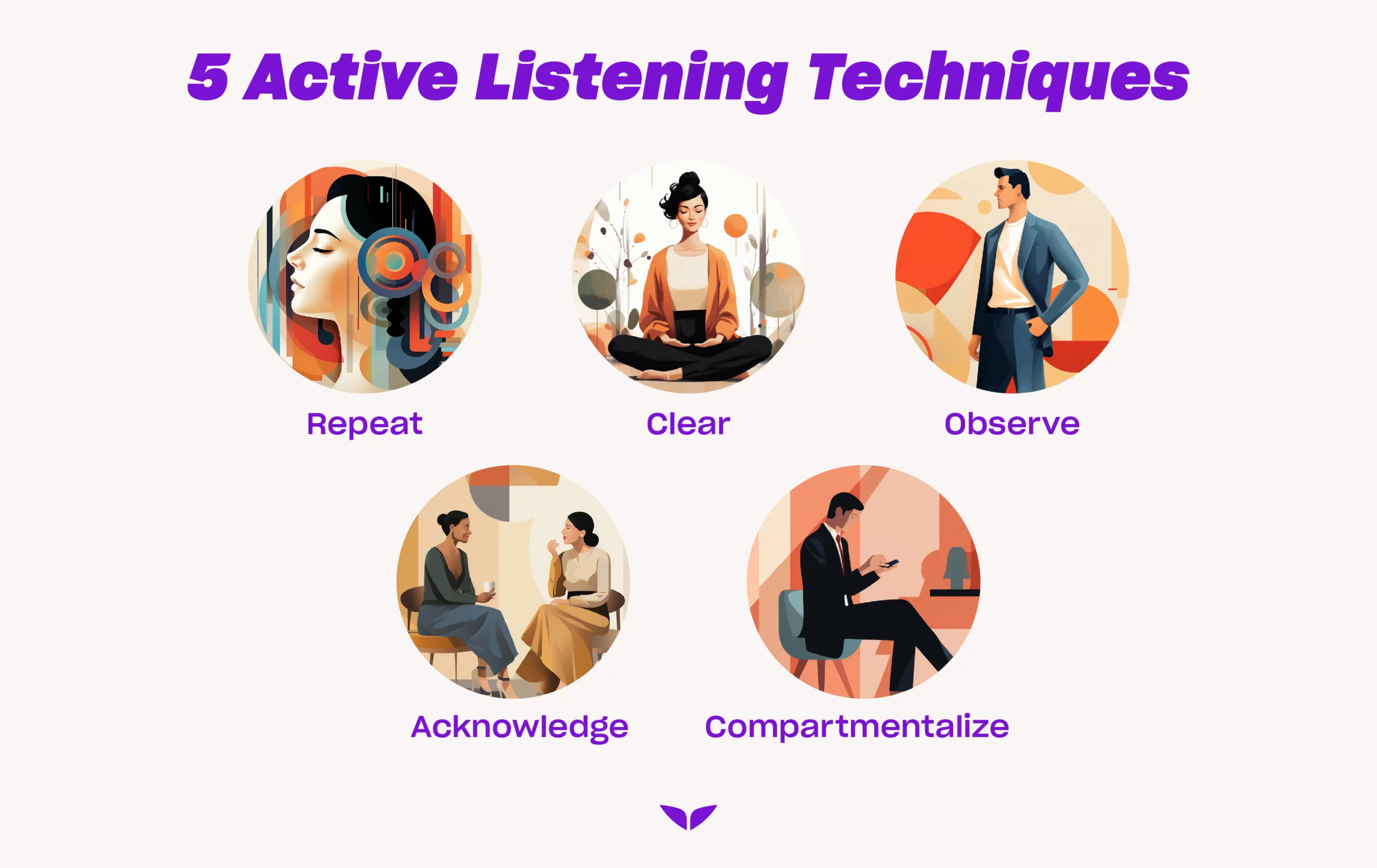Whether you’re an entrepreneur, teacher, or stay-at-home mom, active listening is the key to having more meaningful and impactful conversations.
Which is why, for coaches, it’s a must-have.
Active listening reinforces active participation in the coaching conversation, which leads to more effective communication.
Discover what active listening means and five practices that help you get better at it.
What are active listening skills?
Active listening is about giving your full attention to the person who’s talking to you and seeking to understand them fully before you jump in with a response. It requires you, as a coach, to be fully present, empathetic, and non-judgmental. This allows your clients to express themselves freely.
Coaches who practice this skill pay attention to not just the words but also what’s not being said. In other words, the client’s tone, body language, and even their silence.
Active listening allows coaches to understand their clients’ perspectives deeper, uncover underlying issues, and foster a deeper connection.
Here are seven key listening skills coaches use in conversations:
- Reflective responses. “It sounds like you’re feeling overwhelmed. Is that true?“
- Clarifying questions. “Could you provide more details about the specific challenges you’re facing?“
- Paraphrasing. “If I understand correctly, you’re saying that balancing work and personal life is a major stressor for you?“
- Summarizing. “So, to recap, you’re dealing with work-related stress and finding it challenging to maintain a healthy work-life balance?“
- Empathetic statements. “I can imagine that managing these responsibilities is quite demanding. How does that make you feel?“
- Open-ended questions. “Can you tell me more about what led to that decision?“
- Silence. Allowing brief pauses, giving the client time to collect their thoughts and share more.
Try these examples in your next session to dig deeper into the issue your client is facing.
How to improve active listening skills: 5 techniques to try
Try these active listening techniques to get better at this key coaching skill with every conversation.
1. Repeat
When you start to consciously practice active listening, you’ll discover just how hard it is to give your complete focus and attention to someone else. But here’s a clever hack you can try: The next time you talk to someone, boost your concentration by repeating some of their key words and phrases in your mind.
This is a discreet, yet remarkably effective method to kick your focus up a notch.
You can also ask them an appropriate question or two to make sure you’ve understood their point.
Doing this will help you to stay in the moment and remember what’s being said. It’ll also help you come through with the right responses at the right time, which is a big part of this skill.
2. Clear
One of the biggest obstacles to active listening is the tendency to have a continuous “soundtrack” of your own thoughts and ideas playing in your head.
When you’re thinking about your response or what you’re going to have for lunch, you lose track of what’s being said.
Committing to a regular meditation practice is the perfect way to lessen unwanted mental chatter and practice bringing your focus back to what’s happening in front of you.
In just a few meditation sessions, you’ll find that it’s a lot easier to call on your full focus and attention when you need to practice active listening during a conversation.
3. Observe
Studies show that over 90% of communication takes place via nonverbal cues. What this means is that body language is far more important than words when you want to achieve true understanding in a conversation.
Learn about what different body postures and facial expressions mean. Alternatively, simply practice paying more attention to them.
Keep in mind that even experts often misread body language cues. So, if you pick up on something, ask your clients how they feel first before jumping to conclusions.
4. Acknowledge
Part of the magic of active listening happens when the other person feels heard and understood. So show them that you’re listening closely and following along with what they’re saying.
You can nod your head or acknowledge verbally that you’re listening by saying short phrases like “I see,” “yes,” and “right.” If you’d like to encourage your client to expand upon a topic, you can also ask them, “How so?” or say, “Tell me more.”
This shows that you’re immersed in the conversation and interested in your client’s message.
5. Compartmentalize
A coaching session is a space and time when nothing else should be catching your attention other than your client. Phone off, door closed, and all other issues temporarily put on hold.
Conduct your coaching sessions in a quiet space where there aren’t any distractions for either you or your client. Stay away from community offices with glass-door meeting rooms, and let any team members in your office know when a session is on and you want zero disruptions.
Develop a habit of single-tasking in your everyday work to teach your mind that once you’re in the zone, all other unfinished business can wait.
Practicing these techniques will help you improve your active listening skills until they become a natural part of every conversation. It’s one of the best things you can do for your clients and the people who matter to you.

Take the next step in your coaching career
Active listening, just like any skill, takes practice. Apply these five approaches in your next coaching session to get better at it and help your clients achieve bigger breakthroughs.
Uncover the secret to turning your passion into a purposeful profession: Join us in the Become a Mindvalley Certified Life Coach free masterclass.









